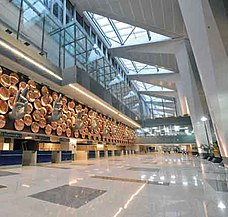Indira Gandhi International Airport
Indira Gandhi International Airport (IATA: DEL, ICAO: VIDP) serves as the major international aviation hub of the Indian capital city of New Delhi as well as India. The airport, spread over an area of 5,106 acres (2,066 ha),[4] is situated in Palam, 15 km (9.3 mi) south-west of the New Delhi railway station and 16 km (9.9 mi) from New Delhi city centre.[5][6] Named after former Prime Minister of India Indira Gandhi, it is the busiest airport in India in terms of passenger traffic since 2009.[7] It is also the busiest airport in the country in terms of cargo traffic, overtaking Mumbai during late 2015. In the calendar year 2018, it was the 12th busiest airport in the world and 6th busiest airport in Asia by passenger traffic handling nearly 70 million passengers.[8] It is the world's busiest airport for Airbus A320 aircraft.[9] The under construction expansion program will increase the airport's capacity to handle 100 million passengers by 2030.[10]
Indira Gandhi International Airport | |||||||||||||||||||
|---|---|---|---|---|---|---|---|---|---|---|---|---|---|---|---|---|---|---|---|
 | |||||||||||||||||||
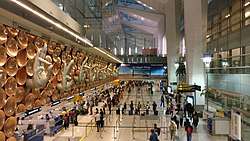 | |||||||||||||||||||
| Summary | |||||||||||||||||||
| Airport type | Public | ||||||||||||||||||
| Owner |
| ||||||||||||||||||
| Operator | Delhi International Airport Pvt Ltd (DIAL) | ||||||||||||||||||
| Serves | Delhi/ NCR | ||||||||||||||||||
| Location | Palam, Delhi, India | ||||||||||||||||||
| Hub for | |||||||||||||||||||
| Elevation AMSL | 237 m / 777 ft | ||||||||||||||||||
| Coordinates | 28°34′07″N 077°06′44″E | ||||||||||||||||||
| Website | Delhi Airport | ||||||||||||||||||
| Map | |||||||||||||||||||
 DEL/VIDP  DEL/VIDP 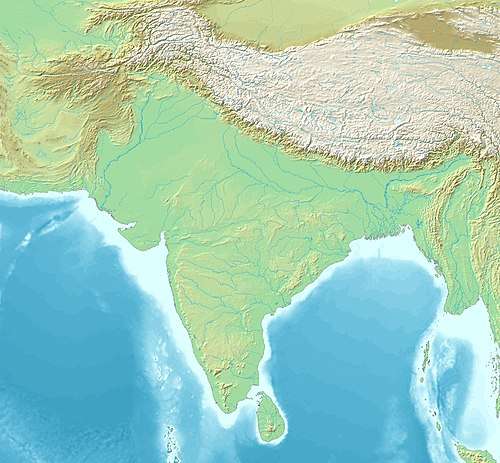 DEL/VIDP 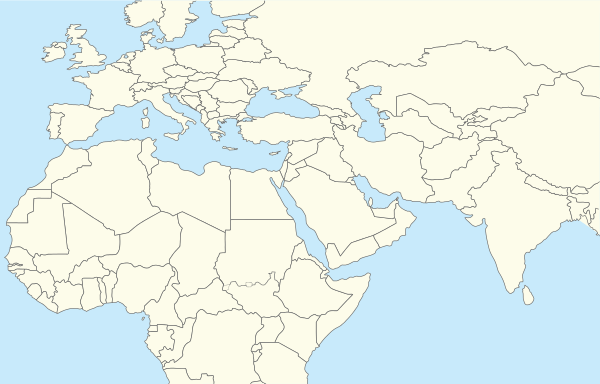 DEL/VIDP 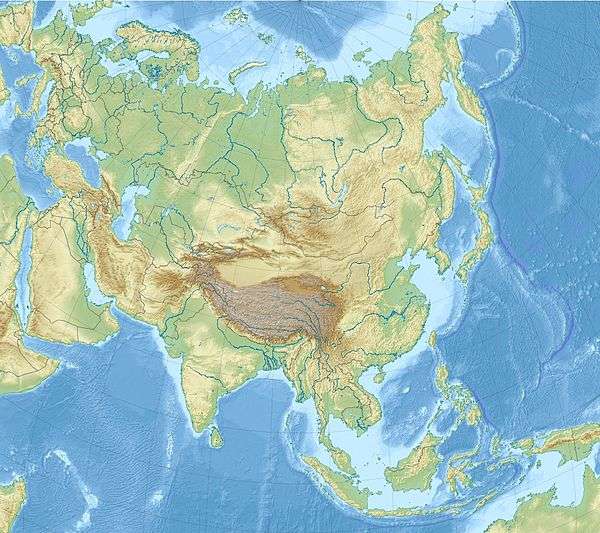 DEL/VIDP | |||||||||||||||||||
| Runways | |||||||||||||||||||
| |||||||||||||||||||
| Statistics (2019-20) | |||||||||||||||||||
| |||||||||||||||||||
The airport was operated by the Indian Air Force before its management was transferred to the Airports Authority of India.[11] In May 2006, the management of the airport was passed over to Delhi International Airport Limited (DIAL), a consortium led by the GMR Group.[12] In September 2008, the airport inaugurated a 4,430 m (14,530 ft) runway. With the commencement of operations at Terminal 3 in 2010, it became India's and South Asia's largest aviation hub. The Terminal 3 building has a capacity to handle 34 million passengers annually and was the world's 8th largest passenger terminal upon completion.[6] The airport uses an advanced system called Airport Collaborative Decision Making (A-CDM) to help keep takeoffs and landings timely and predictable.[13]
In 2010, IGIA was conferred the fourth best airport award in the world in the 15–25 million category, and Best Improved Airport in the Asia-Pacific Region by Airports Council International.[14] The airport was rated as the Best airport in the world in the 25–40 million passengers category in 2015, by Airports Council International.[15][16] Delhi Airport was awarded The Best Airport in Central Asia and Best Airport Staff in Central Asia at the Skytrax World Airport Awards 2015.[17] IGI also stood first in the new rankings for 2015 Airport Service Quality (ASQ) Awards conducted by Airports Council International.[18] The airport, along with Mumbai Airport was adjudged "World's Best Airport" at Airport Service Quality Awards 2017 in the highest category of airports handling more than 40 million passengers annually.[19]
The other airport serving Delhi NCR is Hindon Airport which is much smaller in size and primarily handles regional flights out of the city under the government's UDAN.[20] Safdarjung Airport is used mainly by VVIP helicopters and small charter helicopters due to its short runway. Jewar Airport is being planned to offset the load of Indira Gandhi International Airport.[21]
History
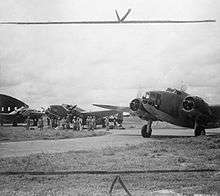
Safdarjung Airport was built in 1930 and was the main airport for Delhi until 1962.[4] Due to increasing passenger traffic at Safdarjung, civilian operations were moved to Palam Airport (later renamed to IGIA) in 1962.[4] Palam Airport had been built during World War II as RAF Station Palam and after the British left, it served as an Air Force Station for the Indian Air Force.
- Units
- No. 31 Squadron RAF[22]
- No. 34 Squadron RAF[23]
- No. 62 Squadron RAF[24]
- No. 76 Squadron RAF[25]
- No. 194 Squadron RAF[26]
- No. 232 Squadron RAF[27]
- No. 353 Squadron RAF[28]
- No. 681 Squadron RAF[29]
- Air Headquarters India Communication Squadron RAF[30]
- Base Air Forces, Southeast Asia Communication Squadron RAF[31]
- Supreme Commander's Headquarters (Air) Communication Squadron RAF[32]
Palam Airport had a peak capacity of around 1,300 passengers per hour.[4] In 1979-80, a total of 3 million domestic and international passengers flew into and out of Palam Airport.[33] Owing to an increase in air traffic in the 70s and the 80's, an additional terminal with nearly four times the area of the old Palam terminal was constructed. With the inauguration of this new international terminal, Terminal 2, on 2 May 1986, the airport was renamed as Indira Gandhi International Airport (IGIA).[4]
The old domestic airport (Palam) is known as Terminal 1 and was divided into separate buildings- 1A, 1B, and 1C. Blocks 1A and 1B used to handle international operations while domestic operations took place in 1C. Today, block 1A became a dedicated terminal for domestic Air India, which is now demolished. Block 1B was used as a departures-only terminal by all other domestic airlines, which is also demolished. Block 1C was turned into a domestic arrivals-only terminal, and the newly constructed domestic departure block 1D is now used by all domestic low-cost airlines (GoAir, IndiGo, SpiceJet). There is also a separate Technical Area for VVIP passengers.
Significant growth in Indian aviation industry led to a major increase in passenger traffic. The capacity of Terminal 1 was estimated to be 7.15 million passengers per annum (mppa). Actual throughput for 2005/06 was an estimated 10.4 million passengers. Including the closed down international terminal (Terminal 2), the airport had a total capacity of 12.5 million passengers per year, whereas the total passenger traffic in 2006/07 was 16.5 million passengers per year.[34] In 2008, total passenger count at the airport reached 23.97 million. In order to ease the traffic congestion on the existing terminals, a much larger Terminal 3 was constructed and inaugurated on 3 July 2010.[35] The new terminal's construction took 37 months for completion and this terminal increased airport's total passenger capacity by 34 million.[35] Apart from the three budget domestic airlines handled by Terminals 1C-1D, all other airlines operate their flights from Terminal 3.
Ownership
On 31 January 2006, the aviation minister Praful Patel announced that the empowered Group of Ministers have agreed to sell the management-rights of Delhi Airport to the DIAL consortium and the Mumbai airport to the GVK Group.[36] On 2 May 2006, the management of Delhi and Mumbai airports were handed over to the private consortia.[37] Delhi International Airport Limited (DIAL) is a consortium of the GMR Group (54%), Fraport (10%) and Malaysia Airports (10%),[38] and the Airports Authority of India retains a 26% stake.[39]
Nine years later, in May 2015, Malaysia Airports chose to exit from DIAL venture and sold its entire 10% stake to majority share holder GMR Infra for $79 million. Following this GMR Group's stake at DIAL increased to 64%.[40] Earlier GMR indicated that it was interested in buying out the 10% stake of Fraport.[41]
Facilities
Runways
_Interior_of_New_Delhi_Airport.jpg)
| Runway Number | Length | Width | Approach Lights/ILS[6] |
|---|---|---|---|
| 29/11 | 4,430 m (14,530 ft) | 60 m (200 ft) | CAT III-B / CAT III-B |
| 28/10 | 3,810 m (12,500 ft) | 46 m (151 ft) | CAT III-B / CAT I |
| 27/09 | 2,813 m (9,229 ft) | 45 m (148 ft) | CAT I / CAT I |
Delhi Airport has three near-parallel runways: runway 11/29, 4,430 m × 60 m (14,530 ft × 200 ft) with CAT IIIB instrument landing system (ILS) on both sides, runway 10/28, 3,810 m × 46 m (12,500 ft × 151 ft), and runway 09/27, 2,813 m × 45 m (9,229 ft × 148 ft). In addition to Chaudhary Charan Singh International Airport in Lucknow and Jaipur Airport in Jaipur, Delhi Airport is the only airports in India to have been equipped with the CAT III-B ILS.[42] In the winter of 2005, there were a record number of disruptions at Delhi airport due to fog/smog. Since then some domestic airlines have trained their pilots to operate under CAT-II conditions of a minimum 350 m (1,150 ft) visibility. On 31 March 2006, IGI became the first Indian airport to operate two runways simultaneously following a test run involving a SpiceJet plane landing on runway 28 and a Jet Airways plane taking off from runway 27 at the same time.
The initially proposed mode involving simultaneous takeoffs in westerly flow to increase handling traffic capacity caused several near misses over the west side of the airport where the centrelines of runways 10/28 and 9/27 intersect.[43] The runway use was changed to segregate dependent mode on 25 December 2007, which was a few days after the deciding near miss involving an Airbus A330-200 of Qatar Airways and an Indigo A320 aircraft. The new method involved use of runway 28 for all departures and runway 27 for all arrivals. This mode which was more streamlined was adopted during day hours (0600 – 2300 IST) till 24 September 2008.
On 21 August 2008, the airport inaugurated its 3rd runway 11/29 costing ₹10 billion[44] and 4,430 m (14,534 ft) long. The runway has one of the world's longest paved threshold displacements of 1,460 m (4,790 ft). This, in turn decreases the available landing length on runway 29 to 2,970 m (9,744 ft). The purpose of this large threshold displacement is to reduce noise generated by landing aircraft over nearby localities. The runway increases the airport's capacity to handle up to 100 flights from the previous 45–60 flights per hour. The new runway was opened for commercial operations on 25 September 2008 and gradually began full round-the-clock operations by the end of October the same year.[45]
Since mid 2012 all three runways are operated simultaneously to handle traffic during day hours.[46] Only runways 11/29 and 10/28 are operated during night (2300–0600 IST) hours with single runway landing restriction during westerly traffic flow that is rotated late night (0300 IST) and reversed weekly to distribute and mitigate night time landing noise over nearby residential areas.[47]
To cater for the demand of increasing air traffic, the master plan for the construction of a fourth parallel runway next to the existing runway 11/29 has been cleared.[48]
Terminals
IGI Airport serves as a major hub or a focus destination for several Indian carriers including Air India, Air India Regional, IndiGo, SpiceJet, GoAir and Vistara. Approximately 80 airlines serve this airport. At present there are three active scheduled passenger terminals, a dedicated Hajj terminal and a cargo terminal.
Domestic and international operations
Terminal 3 is used for international flights. The Indian carriers operating international flights (as of 2 October 2019) are Air India, Indigo, SpiceJet, GoAir and Vistara.
As far as domestic operations are concerned, Terminal 3 is used by Air India, AirAsia, Vistara and Indigo
GoAir and Indigo use Terminal 2, while SpiceJet uses Terminal 1 and Terminal 3 (temporarily) for their domestic operations.
Terminal 1
Terminal 1 is currently used by low cost carriers IndiGo and SpiceJet. DIAL is working to expand Terminal 1 and enhance its annual passenger handling capacity from the current 18 million to 30 million within four years by 2022.[49]
Terminal 1A
Terminal 1A was built in the late 1980s to cater to Indian Airlines. It had to be refurbished after a fire gutted the interiors and DIAL significantly upgraded the terminal. It was used by Air India for its Airbus operations until it shifted to the new Terminal 3 on 11 November 2010.[50] The terminal is now closed and is expected to be torn down on the completion of newer terminals.
Terminal 1C
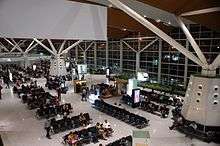
Terminal 1C is used only for domestic arrivals. The terminal has been upgraded with a new expanded greeting area and a larger luggage reclaim area with eight belts.
Terminal 1D
Terminal 1D is the newly built domestic departure terminal with a total floor space of 53,000 m2 (570,000 sq ft) and has a capacity to handle 15 million passengers per year.[51] Terminal 1D commenced operations on 19 April 2009.[52] It has 72 Common Use Terminal Equipment (CUTE) enabled check-in counters, 16 self check-in counters, and 16 security channels.[52]
Terminal 2
Terminal 2 was opened on 1 May 1986, at a cost of ₹950 million[4] and was used for international flights until July 2010 when operations shifted to Terminal 3. After this, the terminal remained operational for only three months per year catering to Hajj flights.[53] In 2017, after revamping Terminal 2 at a cost of ₹1 billion,[53] DIAL shifted operations of GoAir to the terminal from 29 October in order to continue expansion work of T1.[54][55] Now, GoAir along with Indigo operates its daily flights from this terminal.
Terminal 3
Designed by HOK working in consultation with Mott MacDonald,[56] the new Terminal 3 is a two-tier building spread over an area of 20 acres (8.1 ha), with the lower floor being the arrivals area, and the upper floor being a departures area. This terminal has 168 check-in counters, 78 aerobridges at 48 contact stands, 54 parking bays, 95 immigration counters, 15 X-ray screening areas, shorter waiting times, duty-free shops, and other features.[57][58] This new terminal was timed to be completed for the 2010 Commonwealth Games, which was held in Delhi and is connected to Delhi by an eight-lane Delhi Gurgaon Expressway and the Delhi Metro. The terminal was officially inaugurated on 3 July 2010. All international airlines shifted their operations to the new terminal in late July 2010 and all full service domestic carriers in November 2010. The arrival area is equipped with 14 baggage carousels. T3 has India's first automated parking management and guidance system in a multi level car park, which comprises seven levels and a capacity of 4,300 cars. Terminal 3 forms the first phase of the airport expansion which tentatively includes the construction of additional passenger & cargo terminals (Terminal 4, 5 & 6).[59]
Domestic full-service airlines operate from Terminal 3 including Air India, the national carrier. The Tata & Singapore Airlines airline joint-venture Vistara also operates from Terminal 3.[60] AirAsia India, although a low cost airline, also operates its domestic flights from this terminal.
WorldMark is an upcoming mixed-use project in the Aerocity hospitality district near Terminal 3.
Cargo
The air cargo complex is located at a distance of 1 km (0.62 mi) from T3. It consists of separate brownfield and greenfield cargo terminals.[61] The cargo operations at the brownfield terminal are managed by Celebi Delhi Cargo Management India Pvt. Ltd., which is a joint venture between Delhi International Airport Private Ltd (DIAL) and the Turkish company Celebi Ground Handling (CGH).[62] CGH was awarded the contract to develop, modernise, and finance the existing cargo terminal and to operate the terminal for a period of twenty-five years by DIAL in November 2009.[63] It started its operations in June 2010.[63] In addition to the existing terminal, a new greenfield terminal is being developed in phases by Delhi Cargo Service Centre (DCSC), also a joint venture between DIAL and Cargo Service Center (CSC).[63] The Greenfield cargo terminal project consists of two terminals built over a plot of 48,000 square metres and 28,500 square metres respectively. Phase-1A of the project has been completed and is fully operational.[61] Once the entire project is completed, these two new terminals will have an annual handling capacity of 1.25 million tonnes.[63] The cargo operations of the airport received "e-Asia 2007" award in 2007 for "Implementation of e- Commerce / Electronic Data Interchange in Air Cargo Sector".[64]
Airlines and destinations
Passenger
Cargo
Connectivity
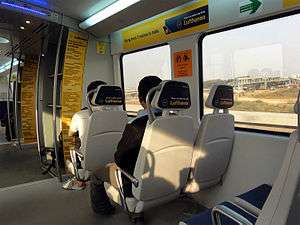
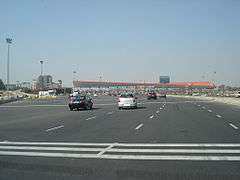
Rail
The nearest railway station is the Palam railway station, located 4.8 kilometres (3.0 mi) and 12 kilometres (7.5 mi) from terminals 1 and 3 respectively. Several passenger trains run regularly between these stations. Shahabad Mohammadpur (SMDP) is equally close.[162][163]
Terminals 2 and 3 of the airport are served by the Airport metro station on Delhi Airport Metro Express line. The 22.7 km (14.1 mi) line runs from Dwarka Sector 21 to the New Delhi metro station with trains running every 10 minutes.[164] Terminal 1 is served by the Terminal 1-IGI Airport metro station on the Magenta Line.[165]
Road
The airport is connected by the 8-lane Delhi Gurgaon Expressway. Air conditioned low-floor buses operated by Delhi Transport Corporation (DTC) regularly run between the airport and the city. Metered taxis are also available from terminals T3 and T1C to all areas of Delhi.[166]
Future expansion
Terminals 4, 5 and 6 will be built at a later stage, which will be triggered by growth in traffic. Once completed, all international flights will move to these three new terminals. Terminal 3 will then be solely used for handling domestic air traffic. A new cargo handling building is also planned. According to Delhi International Airport Limited (DIAL), these new terminals will increase the airport's annual passenger volume capacity to 100 million.[59]
DIAL submitted a plan in 2016 to the then aviation secretary R N Choubey regarding expansion of the airport with a new fourth runway and Terminal 4 in a phased manner.[49] The Master Plan of Airport in 2016 was then reviewed and updated by DIAL in consultation with the Airports Authority of India.[167] The terminal construction will start after the fourth runway is completed and expansion of terminals 1 and 3.[49]
Accidents and incidents
- 1970: A Royal Nepal Airlines Fokker F27-200 (9N-AAR) after a flight from Kathmandu, Nepal was caught in severe thunderstorms with turbulence and downdrafts on final approach to Palam Airport. The pilot lost control of the aircraft and crashed short of the runway. Of the five crew and 18 passengers, one crew member was killed.[168]
- 1972: Japan Airlines Flight 471 crashed outside of Palam Airport, killing 82 of 87 occupants; ten of eleven crew members and 72 of 76 passengers died, as did three people on the ground.[169]
- 1973: Indian Airlines Flight 440 crashed while on approach to Palam Airport, killing 48 of the 65 passengers and crew on board.[170][171]
- 1990: An Air India Boeing 747 flying on the London-Delhi-Mumbai route and carrying 215 people (195 passengers and 20 crew) touched down at Indira Gandhi International Airport after a flight from London Heathrow Airport. On application of reverse thrust, a failure of the no. 1 engine pylon to wing attachment caused this engine to tilt nose down. Hot exhaust gases caused a fire on the left wing. There were no casualties but the aircraft was damaged beyond repair and written off.[172]
- 1994: A Sahara Airlines Boeing 737-2R4C (registered VT-SIA) crashed while performing a training flight killing all four people on board and one person on the ground.[173] Wreckage struck an Aeroflot Ilyushin-86 (registered RA-86119) parked nearby, killing four people inside.[174]
- 1995: Indian Airlines Flight 492 (IC 492), A Boeing 737-2A8 (Registered VT-ECS), damaged beyond repair when the aircraft overshot the runway at Delhi airport due to pilots error, on its scheduled flight from Jaipur to Delhi.[175]
- 1996: The airport was involved in the Charkhi Dadri mid-air collision when a Saudia Boeing 747-100B, climbing out after take-off, collided with an incoming Kazakhstan Airlines Ilyushin Il-76 chartered by a fashion company, causing the deaths of all 349 people on board the two planes.[176]
See also
- Transport in India
- List of airports in India
- List of busiest airports in India
- Aviation in India
References
Citations
- "Traffic News for the month of March 2020: Annexure-III" (PDF). Airports Authority of India. 21 May 2020. p. 3. Retrieved 21 May 2020.
- "Traffic News for the month of March 2020: Annexure-II" (PDF). Airports Authority of India. 21 May 2020. p. 3. Retrieved 21 May 2020.
- "Traffic News for the month of March 2020: Annexure-IV" (PDF). Airports Authority of India. 21 May 2020. p. 3. Retrieved 21 May 2020.
- About IGI Airport from the Wayback Machine
- eAIP India, OF Airports Authority of India, 1 April 2012, archived from the original on 31 March 2014
- "Fact Sheet". Newdelhiairport.in. Retrieved 5 May 2014.
- "Delhi Airport busier than Mumbai by 40 flights a day". The Indian Express. 16 August 2009. Retrieved 5 May 2014.
- "Traffic News for the month of January 2017: Annexure III" (PDF). Airports Authority of India. p. 3. Archived (PDF) from the original on 2 February 2018. Retrieved 1 March 2018.
January 2017: 5,197,483
- "Traffic News for the month of February 2017: Annexure III" (PDF). Airports Authority of India. p. 3. Archived (PDF) from the original on 2 February 2018. Retrieved 1 March 2018.
February 2017: 4,817,470
- "Traffic News for the month of March 2017: Annexure III" (PDF). Airports Authority of India. p. 3. Archived (PDF) from the original on 2 February 2018. Retrieved 1 March 2018.
March 2017: 5,185,966
- "Traffic News for the month of December 2017: Annexure III" (PDF). Airports Authority of India. p. 3. Archived (PDF) from the original on 2 February 2018. Retrieved 1 March 2018.
April–December 2017: 48,250,584
Total passengers in calendar year 2017: 63,451,503
- "Traffic News for the month of February 2017: Annexure III" (PDF). Airports Authority of India. p. 3. Archived (PDF) from the original on 2 February 2018. Retrieved 1 March 2018.
- "Delhi airport is the busiest in the world for Airbus A320 flights". Business Standard. 17 December 2016. Retrieved 3 August 2017.
- Grammaticas, Damian (9 May 2007). "Sky's the limit for India flight boom". BBC News. Retrieved 5 May 2014.
- "Why they should stay with the Air Force". Business Line.
- "Mumbai, Delhi airport management to be handed over to pvt cos". Outlookindia.com. Archived from the original on 14 May 2006. Retrieved 5 May 2014.
- "Advance System at IGIA" (Press release). Press Information Bureau, Government of India, Ministry of Civil Aviation. 12 December 2013. Retrieved 12 December 2013.
- ACI Airport Service Quality Awards 2009, Asia Pacific airports sweep top places in worldwide awards from the Wayback Machine
- "Delhi's IGI is world's 2nd best airport for service quality again". Firstpost.
- "Delhi Airport Ranked First for Service Quality". Business Standard. 17 February 2015.
- "Delhi's Indira Gandhi International Airport bags two international awards in Paris". The Economic Times. 17 March 2015. Retrieved 17 March 2015.
- "Indira Gandhi International Airport is world's best airport for second time in a row". India Today. Retrieved 2 March 2016.
- Devanjana Nag (7 March 2018). "Delhi's IGI, Mumbai's Chhatrapati Shivaji airports beat Singapore Changi, Seoul Incheon to become world's best". The Financial Express. Retrieved 2 May 2018.
- "Delhi's second airport to operate first flight from tomorrow". 10 October 2019.
- "Jewar international airport: Inauguration of Jewar airport by end of December: Nandi | Allahabad News - Times of India". The Times of India. Retrieved 18 December 2019.
- Jefford 1988, p. 35.
- Jefford 1988, p. 36.
- Jefford 1988, p. 44.
- Jefford 1988, p. 48.
- Jefford 1988, p. 67.
- Jefford 1988, p. 75.
- Jefford 1988, p. 88.
- Jefford 1988, p. 105.
- Lake 1999, p. 18.
- Lake 1999, p. 35.
- Lake 1999, p. 279.
- "Travellers can breathe freely with brand new and improved terminal at Sahar in Bombay". India Today. 31 December 1980. Retrieved 14 August 2019.
- "IGI Airport tops world in growth". The Times of India. 19 January 2008. Retrieved 5 May 2014.
- "Brand New Beginning – New Integrated Passenger Terminal 3 Inaugurated at IGIA". GMR Group. 3 July 2010. Retrieved 27 January 2017.
- "Delhi, Mumbai airport modernisation – Efforts to ensure a smoother journey". Business Line. Archived from the original on 4 October 2012. Retrieved 16 July 2010.
- "Mumbai, Delhi airport management to be handed over to pvt cos". news.outlookindia.com. Archived from the original on 15 July 2011. Retrieved 16 July 2010.
- "Malaysia Airports Holdings Berhad". Malaysiaairports.com.my. 4 April 2006. Retrieved 16 July 2010.
- Sandeep Sharma (31 March 2010). "Equipment India – India's first infrastructure equipment magazine". Constructionupdate.com. Archived from the original on 28 December 2010. Retrieved 16 July 2010.
- "GMR Infrastructure acquires 10% additional share in Delhi airport overall stake rises to 64%". Retrieved 18 August 2015.
- "Malaysia Airports sells Delhi International Airport stake to GMR". 24 March 2015. Retrieved 18 August 2015.
- "AAI commits more airports for CAT III ILS compliance". Daily News and Analysis. ANI. 4 February 2017. Retrieved 4 May 2018.
- Saurabh Sinha; Neha Lalchandani (19 December 2007). "Now separate runways at Delhi airport". The Times of India. New Delhi. TNN. Retrieved 4 May 2018.
- Express News Service (22 August 2008). "Air India Boeing opens Rs 1,000 cr runway at IGIA". Express India. Retrieved 29 October 2012.
- "Delhi's airport opens third runway for round-the-clock operation". Business Line. 31 October 2008. Retrieved 4 May 2018.
- Neha Lalchandani (26 June 2012). "Indira Gandhi International Airport to use 3 runways together". The Times of India. New Delhi. TNN. Retrieved 4 May 2018.
- Saurabh Sinha (7 April 2017). "Mix-up forces Air India plane to do high-speed reject at Delhi Airport". The Times of India. New Delhi. TNN. Retrieved 4 May 2018.
- Faizan Haider (23 August 2017). "Delhi airport new look: Bigger terminals, internal rail but brace for chaos first". Hindustan Times. Delhi. Retrieved 4 May 2018.
- "DIAL plans 4th runway at IGI by 2020, new terminal too". The Times of India. Retrieved 29 May 2017.
- "End of an era at Terminal 1 A". Hindustan Times. 10 November 2010. Retrieved 3 May 2017.
- "Terminal 1D expansion work to begin by year end". The Hindu. 16 August 2016. Retrieved 3 May 2017.
- "Delhi Airport's new Terminal 1D to open on April 19". NetIndian. 14 April 2009. Retrieved 3 May 2017.
- Express Web Desk (17 October 2017). "IGI T2: GoAir shifts to new terminal 2 from October 29, but IndiGo, SpiceJet reluctant". The Indian Express. New Delhi. Retrieved 8 May 2018.
- Arindam Majumder (28 October 2017). "Delhi airport T1 upgrade: GoAir shifts to T2; no nod from IndiGo, Spicejet". Business Standard. Retrieved 7 March 2018.
- "Delhi airport: GoAir to shift operations to T2 from October 29". The Indian Express. Press Trust of India. 13 October 2017. Retrieved 7 March 2018.
- "IGI Airport in India to unveil world's third largest terminal". World Interior Design Network. Archived from the original on 6 June 2010. Retrieved 16 July 2010.
- "Delhi International Airport (P) Limited". Gmrgroup.co.in (GMR). Archived from the original on 10 April 2010. Retrieved 5 May 2014.
- "DIAL to invest Rs 30,000 cr, build 4 new terminals in Delhi". The Economic Times. 16 April 2008. Retrieved 5 May 2014.
- Urvashi Sarkar (23 June 2010). "New terminal to take off at Delhi airport". The Hindu. Retrieved 20 January 2017.
- "Decks cleared for shift of operations to T3". The Times of India. 11 November 2010. Retrieved 18 November 2001.
- "DIAL invites Expression of Interest (IEoI) for Cargo Village Project at IGI Airport". New Delhi: Official Website of Delhi Airport. 10 February 2013. Retrieved 8 May 2018.
- "Corporate: Celebi Delhi Cargo Terminal Management India Pvt Ltd". Celebi Cargo India. Retrieved 8 May 2018.
- "Air cargo terminals Striving for PPP boost". Indian Transport and Logistics News. Retrieved 8 May 2018.
- "DIAL Cargo gets international 'e ASIA 2007 Award' I.G.I. Airport becomes the First Indian Airport to get this award". 22 September 2007. Archived from the original on 2 February 2017. Retrieved 26 January 2016.
- Liu, Jim (25 June 2019). "Aeroflot adds A350 Delhi service from July 2020". Routesonline. Retrieved 25 June 2019.
- "Flight Schedules". Air Arabia. Retrieved 26 December 2018.
- "Timetable". Air Astana. Retrieved 26 December 2018.
- "Flight Schedules". Air Canada. Retrieved 26 December 2018.
- "Flight Timetable". Air China. Retrieved 26 December 2018.
- "Flight Schedule". Air France. Retrieved 26 December 2018.
- "Air India and Alliance Air schedule list". airindia.in. Retrieved 8 November 2018.
- "Air India Express expands Tiruchirapalli network in Nv S20". Airlineroute. Retrieved 27 February 2020.
- "Express Route Map and Schedule". Air India Express. Retrieved 26 December 2018.
- "Flight Timetable" (PDF). Air Mauritius. Retrieved 26 December 2018.
- "AirAsia flight schedule". airasia.com. Archived from the original on 4 October 2018. Retrieved 8 November 2018.
- "Alitalia flight schedule". Alitalia. Retrieved 26 December 2018.
- "ANA to Elevate the Global Network by Adding 5 Cities to its International Service". ana.co.jp. 19 November 2019. Retrieved 25 March 2020.
- "ANA S20 Tokyo International network changes as of 26NOV19". Airlineroute. Retrieved 26 November 2019.
- "Flight Schedule". Ariana Afghan Airlines. Retrieved 26 December 2018.
- "Новый рейс: Бишкек-Дели-Бишкек !!!".
- "Flight Schedule". Bhutan Airlines. Retrieved 26 December 2018.
- Jebun Nesa Alo (21 April 2019). "Biman to resume Dhaka-Delhi flight as Jet Air bows out". The Daily Star. Retrieved 16 October 2019.
- "Timetables". British Airways. Retrieved 26 December 2018.
- "Flight Timetable". Cathay Pacific. Retrieved 26 December 2018.
- "Flight Timetable". China Airlines. Retrieved 26 December 2018.
- "China Eastern Airline-US Official Site". Retrieved 27 December 2018.
- "Flight Schedule". China Southern Airlines. Retrieved 27 December 2018.
- "Drukair files Tokyo / Dubai schedule from Sep 2020". routesonline. Retrieved 12 August 2019.
- "Flight Schedule". Druk Air. Retrieved 26 December 2018.
- "Flight Schedules". Emirates. Retrieved 27 December 2018.
- "Flight Schedule". Ethiopian Airlines. Retrieved 27 December 2018.
- "Flight Timetables". Etihad Airways. Retrieved 27 December 2018.
- "Timetable". Finnair. Retrieved 27 December 2018.
- "Timetable". Flydubai. Retrieved 27 December 2018.
- Liu, Jim. "flynas schedules Delhi launch in July 2019". Routesonline. Retrieved 14 May 2019.
- "GoAir to commence Delhi-Aizawl service in Mar-2020". CAPA. Retrieved 4 March 2020.
- "GoAir to Colombo". GoAir. Retrieved 28 February 2020.
- "GoAir Flight Schedules". GoAir. Retrieved 11 November 2019.
- "Flight Schedule". GoAir. Retrieved 27 December 2018.
- "Flights Timetable". Gulf Air. Retrieved 27 December 2018.
- "New Flights Information, Status & Schedule | IndiGo". www.goindigo.in.
- "New Flights Information, Status & Schedule | IndiGo". www.goindigo.in.
- "Flight Schedule for Domestic & International Flights". IndiGo. Retrieved 25 December 2018.
- "Iraqi Airways: Book a flight". Retrieved 25 December 2018.
- "JAL files additional S20 Tokyo Haneda International routes". Routesonline. Retrieved 18 December 2019.
- "JAL to move some international routes from Narita to Haneda, add China flights". businesstraveller.com. Retrieved 21 November 2019.
- "Flight Schedules – Timing and Schedules". Jazeera Airways. Retrieved 27 December 2018.
- "Timetable". Kam Air. Retrieved 27 June 2019.
- "Timetable". KLM. Retrieved 27 December 2018.
- "Flight Status & Schedules". Korean Air. Retrieved 27 December 2018.
- "Kuwait stops flights to and from with 7 countries". ARAB TIMES - KUWAIT NEWS. 6 March 2020. Retrieved 7 March 2020.
- "Direct flight from Warsaw to Delhi". LOT Polish Airlines. Retrieved 15 January 2019.
- "Timetable & flight status". Lufthansa. Retrieved 8 November 2018.
- "Mahan Air International Route Network". Mahan Air. Retrieved 21 July 2019.
- "Malaysia Airlines Flights". Malaysia Airlines. Retrieved 27 December 2018.
- "Malindo Air Flights". Malindo Air. Retrieved 27 December 2018.
- "International Flight Schedule". Nepal Airlines. Retrieved 27 December 2018.
- "Flight Schedule". Oman Air. Retrieved 27 December 2018.
- "Flight timetable". Qatar Airways. Retrieved 27 December 2018.
- "Flight Schedule". Saudia. Retrieved 27 December 2018.
- "Shandong Airlines Adds India Service from mid-Nov 2015". Retrieved 9 November 2015.
- "Flight schedules". Retrieved 27 December 2018.
- "Somon Air adds Delhi service from Dec 2019". Airlineroute. Retrieved 24 December 2019.
- "প্রতি দিনই দিল্লির বিমান মেলার আশা নতুন বছরে". anandabazar.com. Retrieved 28 December 2019.
- "SpiceJet flight schedules". Official Website of SpiceJet. Retrieved 11 September 2018.
- "Flight Schedule". SriLankan Airlines. Retrieved 27 December 2018.
- "Timetable". Swiss International Air Lines. Retrieved 27 December 2018.
- "Timetable". Thai Airways. Retrieved 27 December 2018.
- "Istanbul's New Airport Is A Hot Beautiful Mess". One Mile at a Time. 9 April 2019. Retrieved 18 December 2019.
- "Turkmenistan Airlines Home: Date and Locations". Turkmenistan Airlines. Retrieved 27 December 2018.
- "Timetable". Ukraine International Airlines. Retrieved 27 December 2018.
- Liu, Jim. "United extends International / Guam / Micronesia Island Hopper interim schedule to Sep 2020". Airlineroute. Retrieved 5 July 2020.
- "Uzbekistan Airways Summer Flight Schedule". Uzbekistan Airways. Retrieved 23 July 2019.
- "VietJet Air S20 India service expansion". Airlineroute. Retrieved 27 January 2020.
- "VietJet Air schedules Delhi launch in Dec 2019". Routesonline. Retrieved 16 October 2019.
- "Flight schedules". Virgin Atlantic. Retrieved 27 December 2018.
- "Vistara to start flights on Delhi-Dehradun route from Mar 29". The Hindu Business Line. Retrieved 7 February 2020.
- "Vistara announces flights to Kathmandu from February 11". The Economic Times. Retrieved 14 January 2020.
- "Vistara To Commence Flights To London, Paris, And Frankfurt". Simple Flying. 30 July 2020. Retrieved 30 July 2020.
- "Flight Schedule". Vistara. Retrieved 27 December 2018.
- Qureshi, Siraj (1 November 2019). "Zoom Air begins flights from Delhi to Agra, to add new routes. Details here". India Today. Retrieved 29 January 2020.
- "Bismillah Airlines routes". Bismillah Airlines.
- "Corporate details, Blue dart Aviation". Official Website of Blue Dart Aviation. Retrieved 10 September 2015.
- "Check Flight Schedule: Cathay Pacific Cargo". Retrieved 2 May 2018.
- "Network". Cathay Pacific Cargo. Retrieved 2 May 2018.
- "China Airlines Cargo resumes freighter operations to India after four years | Air Cargo News". Stattimes.com. Retrieved 2 December 2016.
- "China Airlines to resume cargo services to India | FOCUS TAIWAN – CNA ENGLISH NEWS". Focustaiwan.tw. 25 August 2016. Retrieved 2 December 2016.
- "DHL AVIATION – FLIGHT SCHEDULE" (PDF). Globe Air Cargo. Retrieved 2 May 2018.
- "Cargo Network". Ethiopian Airlines. Archived from the original on 8 April 2014.
- "Kalitta Air LLC Flight Schedule". Official website of Kalitta Air. Retrieved 2 May 2018.
- "Korean Air launches cargo flights to Delhi, India". Eturbonews. 10 July 2018. Retrieved 2 August 2018.
- "Fleet & Network". Official Website of MASkargo. Retrieved 4 May 2018.
- "MASKargo adds new intra-Asia routing in S18". Routesonline. Retrieved 8 July 2018.
- "Summer 18 Freighter Schedule Issue 3: 1st May to 27th Oct 2018" (PDF). Official Website of Qatar Airways Cargo. p. 2. Retrieved 5 May 2018.
- "SCHEDULED FREIGHTER NETWORK". Official Website of Quikjet Airlines. Archived from the original on 3 May 2018. Retrieved 2 May 2018.
- "SF Airlines commences Shenzhen-Delhi service". CAPA. Retrieved 21 October 2019.
- "Press Release News Page". www.spicejet.com. Retrieved 18 December 2019.
- "Thai Airways launches cargo freighter service from Hyderabad". The Hindu. 13 April 2012. Archived from the original on 21 March 2018. Retrieved 15 April 2016.
- "WINTER 2016 CARGO SCHEDULE (16–22 JAN 2017)" (PDF). Turkish Airlines Cargo. Archived from the original (PDF) on 23 June 2017. Retrieved 27 February 2017.
- "Archived copy". Archived from the original on 29 October 2019. Retrieved 29 October 2019.CS1 maint: archived copy as title (link)
- "Boeing 767-300: flights in a new format from Navoi". Official website of Uzbekistan Airways. 4 March 2015. Retrieved 5 May 2018.
- "Shahabad Mohamadpur/SMDP Railway Station Satellite Map – India Rail Info – A Busy Junction for Travellers & Rail Enthusiasts". India Rail Info. 26 April 2010. Retrieved 24 January 2012.
- "Palam/PM Railway Station Satellite Map – India Rail Info – A Busy Junction for Travellers & Rail Enthusiasts". India Rail Info. 26 April 2010. Retrieved 24 January 2012.
- "Website Airport Metro Express Delhi". delhiairportexpress.com. Archived from the original on 20 June 2012. Retrieved 1 December 2016.
- Sidharatha Roy (24 May 2018). "Metro walks the talk on connect to terminal 1". The Times of India. New Delhi. TNN. Retrieved 28 May 2018.
- "To and From Delhi Airport by Taxi". Official Website. Archived from the original on 30 November 2016. Retrieved 16 December 2018.
- "Master Plan for Expansion of IGI Airport". Press Information Bureau. 15 March 2017. Retrieved 29 May 2017.
- "Accident description". aviation-safety.net. Aviation Safety Network. 25 January 1970. Retrieved 5 May 2014.
- 14 June 1972 Douglas DC-8-53, Japan Air Lines–Aviation Safety Network. Retrieved 23 March 2009.
- "ASN Aircraft accident Boeing 737-2A8 VT-EAM Delhi-Indira Gandhi International Airport (DEL )". Aviation Safety Network. Flight Safety Foundation. Retrieved 31 May 2016.
- "Airline crash in New Delhi." United Press International (UPI) at Lodi News-Sentinel. Friday 1 June 1973. p. 8 (Google News p. 5/16). Retrieved 28 October 2014.
- "Aviation Safety". Aviation Safety. Retrieved 5 May 2014.
- Ranter, Harro. "ASN Aircraft accident Boeing 737-2R4C VT-SIA Delhi-Indira Gandhi International Airport (DEL)". aviation-safety.net. Retrieved 10 June 2020.
- Ranter, Harro. "ASN Aircraft accident Ilyushin Il-86 RA-86119 Delhi-Indira Gandhi International Airport (DEL)". aviation-safety.net. Retrieved 10 June 2020.
- "Major air crashes in India in two decades". The New Indian Express. Retrieved 1 December 2016.
- Burns, John F. (5 May 1997). "One Jet in Crash Over India Ruled Off Course". The New York Times. Retrieved 24 May 2010.
Bibliography
- Jefford, C.G. (1988). RAF Squadrons. A comprehensive record of the movement and equipment of all RAF squadrons and their antecedents since 1912. Shrewsbury: Airlife. ISBN 1-85310-053-6.
- Lake, A (1999). Flying units of the RAF. Shrewsbury: Airlife. ISBN 1-84037-086-6.
External links
![]()
![]()


